engine coolant CHEVROLET SSR 2004 1.G Owners Manual
[x] Cancel search | Manufacturer: CHEVROLET, Model Year: 2004, Model line: SSR, Model: CHEVROLET SSR 2004 1.GPages: 398, PDF Size: 2.49 MB
Page 117 of 398
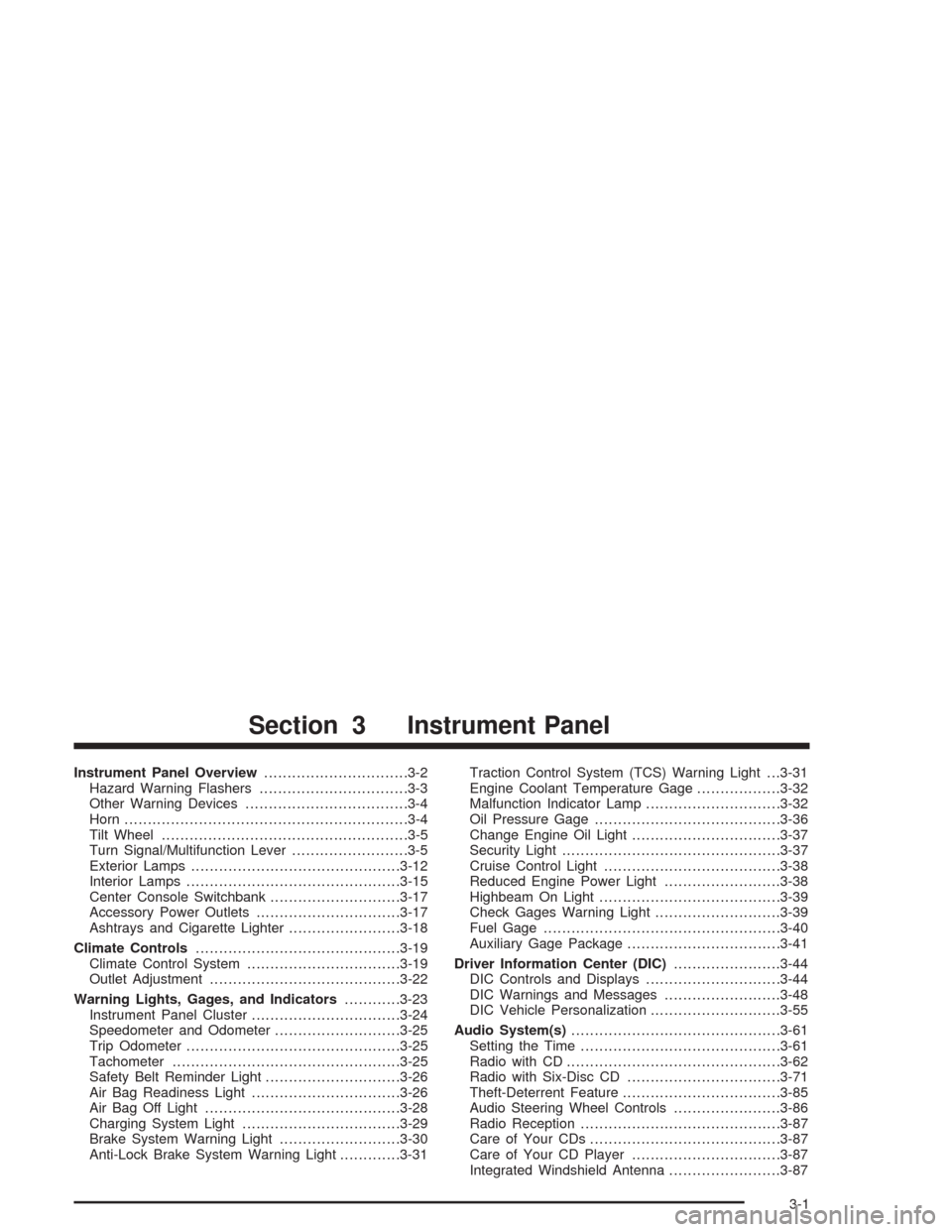
Instrument Panel Overview...............................3-2
Hazard Warning Flashers................................3-3
Other Warning Devices...................................3-4
Horn.............................................................3-4
Tilt Wheel.....................................................3-5
Turn Signal/Multifunction Lever.........................3-5
Exterior Lamps.............................................3-12
Interior Lamps..............................................3-15
Center Console Switchbank............................3-17
Accessory Power Outlets...............................3-17
Ashtrays and Cigarette Lighter........................3-18
Climate Controls............................................3-19
Climate Control System.................................3-19
Outlet Adjustment.........................................3-22
Warning Lights, Gages, and Indicators............3-23
Instrument Panel Cluster................................3-24
Speedometer and Odometer...........................3-25
Trip Odometer..............................................3-25
Tachometer.................................................3-25
Safety Belt Reminder Light.............................3-26
Air Bag Readiness Light................................3-26
Air Bag Off Light..........................................3-28
Charging System Light..................................3-29
Brake System Warning Light..........................3-30
Anti-Lock Brake System Warning Light.............3-31Traction Control System (TCS) Warning Light . . .3-31
Engine Coolant Temperature Gage..................3-32
Malfunction Indicator Lamp.............................3-32
Oil Pressure Gage........................................3-36
Change Engine Oil Light................................3-37
Security Light...............................................3-37
Cruise Control Light......................................3-38
Reduced Engine Power Light.........................3-38
Highbeam On Light.......................................3-39
Check Gages Warning Light...........................3-39
Fuel Gage...................................................3-40
Auxiliary Gage Package.................................3-41
Driver Information Center (DIC).......................3-44
DIC Controls and Displays.............................3-44
DIC Warnings and Messages.........................3-48
DIC Vehicle Personalization............................3-55
Audio System(s).............................................3-61
Setting the Time...........................................3-61
Radio with CD..............................................3-62
Radio with Six-Disc CD.................................3-71
Theft-Deterrent Feature..................................3-85
Audio Steering Wheel Controls.......................3-86
Radio Reception...........................................3-87
Care of Your CDs.........................................3-87
Care of Your CD Player................................3-87
Integrated Windshield Antenna........................3-87
Section 3 Instrument Panel
3-1
Page 148 of 398
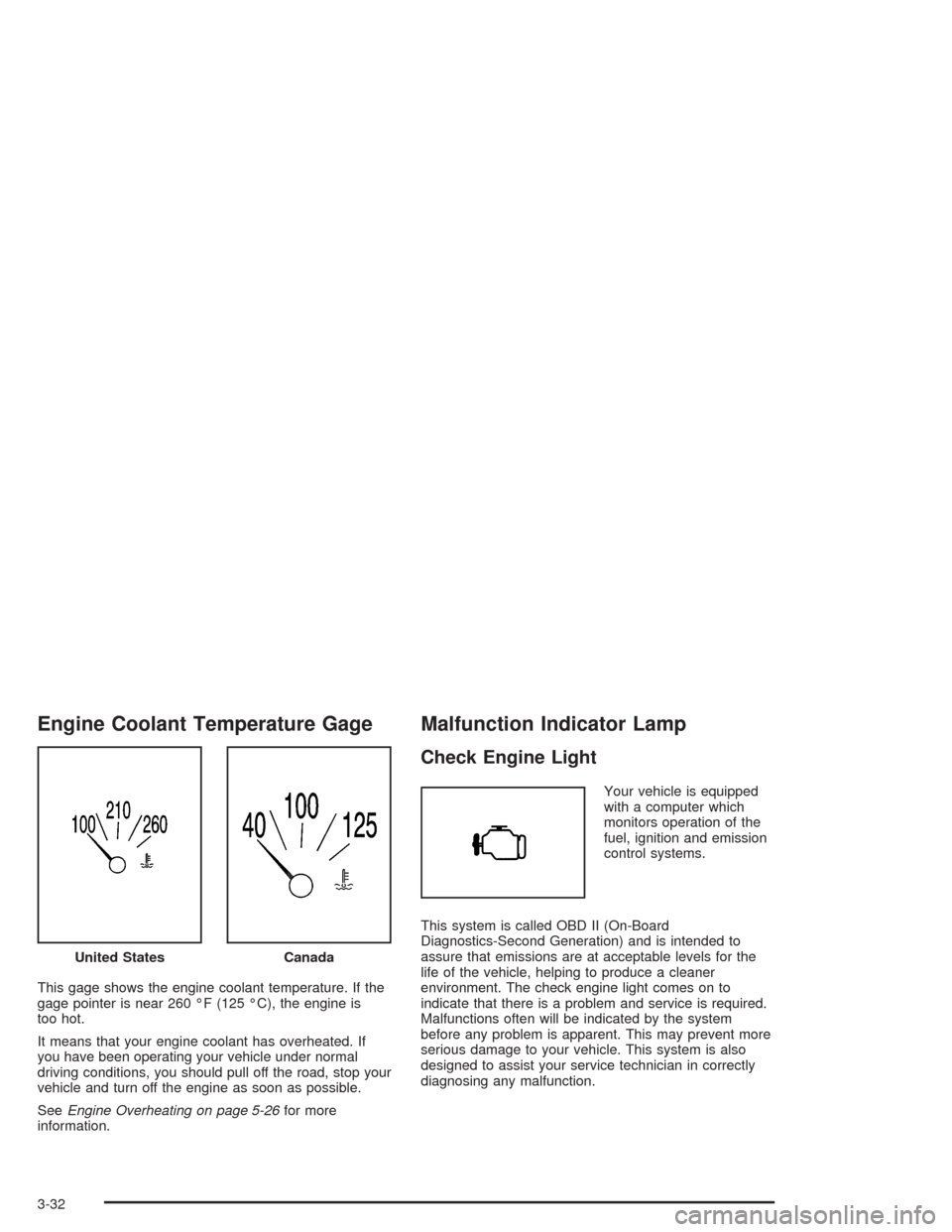
Engine Coolant Temperature Gage
This gage shows the engine coolant temperature. If the
gage pointer is near 260 °F (125 °C), the engine is
too hot.
It means that your engine coolant has overheated. If
you have been operating your vehicle under normal
driving conditions, you should pull off the road, stop your
vehicle and turn off the engine as soon as possible.
SeeEngine Overheating on page 5-26for more
information.
Malfunction Indicator Lamp
Check Engine Light
Your vehicle is equipped
with a computer which
monitors operation of the
fuel, ignition and emission
control systems.
This system is called OBD II (On-Board
Diagnostics-Second Generation) and is intended to
assure that emissions are at acceptable levels for the
life of the vehicle, helping to produce a cleaner
environment. The check engine light comes on to
indicate that there is a problem and service is required.
Malfunctions often will be indicated by the system
before any problem is apparent. This may prevent more
serious damage to your vehicle. This system is also
designed to assist your service technician in correctly
diagnosing any malfunction. United States
Canada
3-32
Page 155 of 398
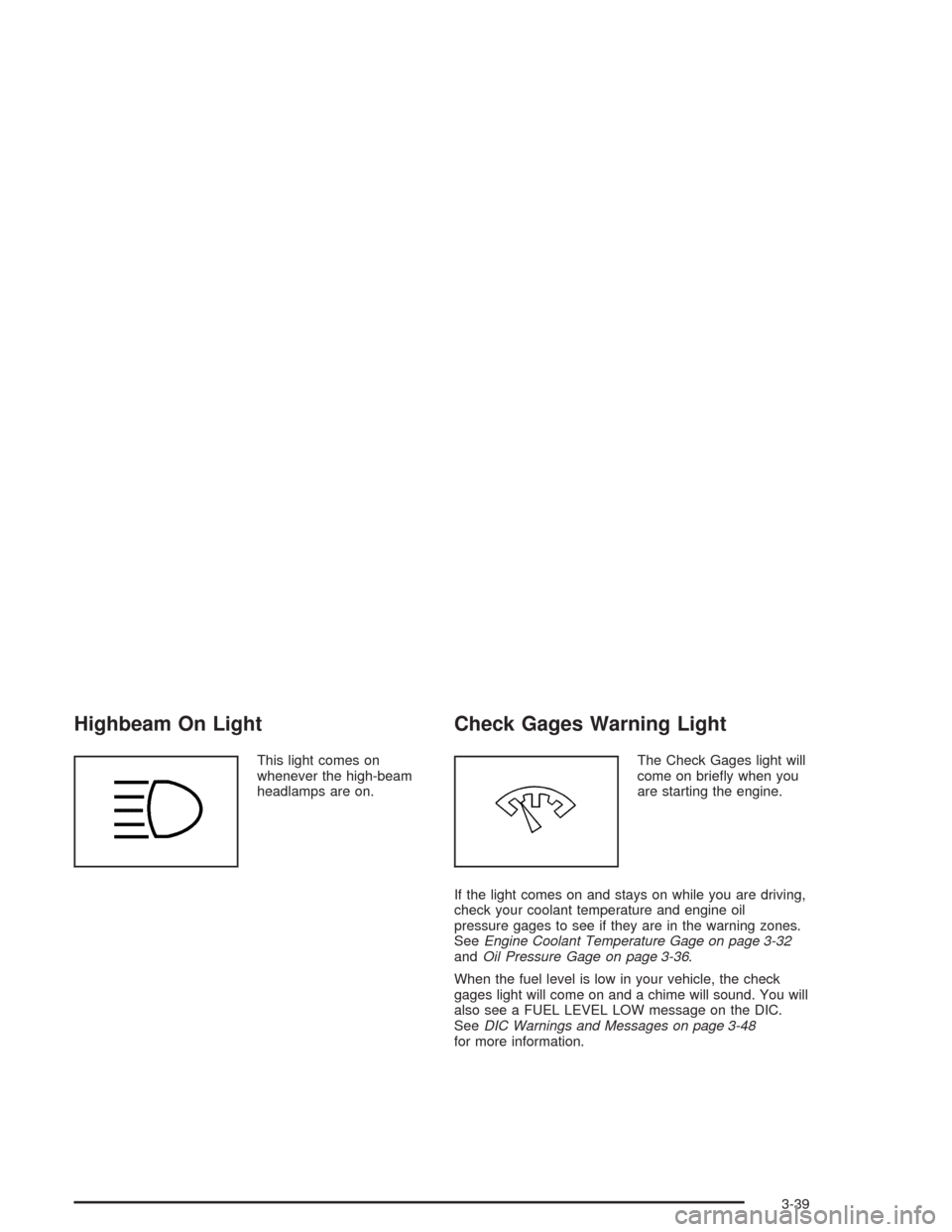
Highbeam On Light
This light comes on
whenever the high-beam
headlamps are on.
Check Gages Warning Light
The Check Gages light will
come on brie�y when you
are starting the engine.
If the light comes on and stays on while you are driving,
check your coolant temperature and engine oil
pressure gages to see if they are in the warning zones.
SeeEngine Coolant Temperature Gage on page 3-32
andOil Pressure Gage on page 3-36.
When the fuel level is low in your vehicle, the check
gages light will come on and a chime will sound. You will
also see a FUEL LEVEL LOW message on the DIC.
SeeDIC Warnings and Messages on page 3-48
for more information.
3-39
Page 166 of 398
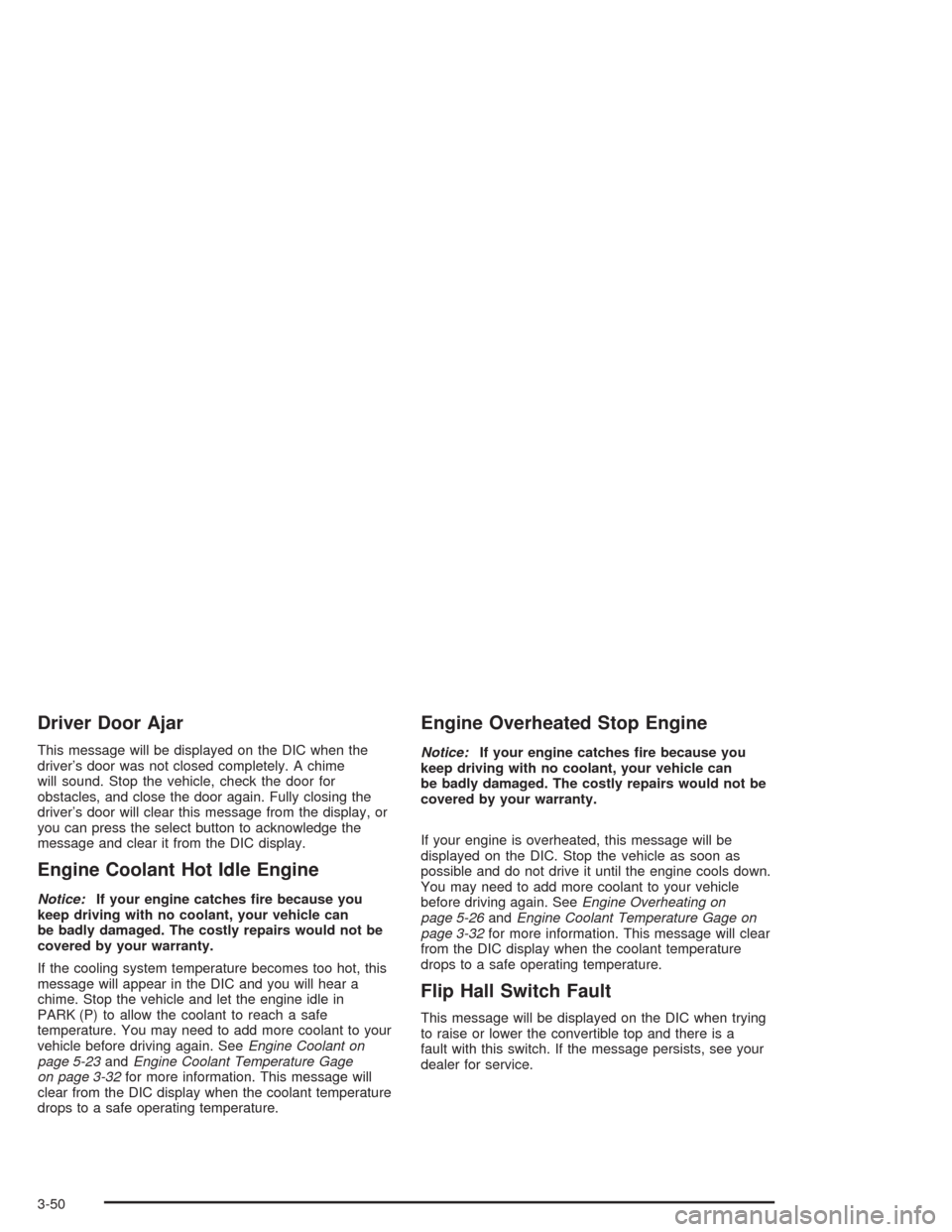
Driver Door Ajar
This message will be displayed on the DIC when the
driver’s door was not closed completely. A chime
will sound. Stop the vehicle, check the door for
obstacles, and close the door again. Fully closing the
driver’s door will clear this message from the display, or
you can press the select button to acknowledge the
message and clear it from the DIC display.
Engine Coolant Hot Idle Engine
Notice:If your engine catches �re because you
keep driving with no coolant, your vehicle can
be badly damaged. The costly repairs would not be
covered by your warranty.
If the cooling system temperature becomes too hot, this
message will appear in the DIC and you will hear a
chime. Stop the vehicle and let the engine idle in
PARK (P) to allow the coolant to reach a safe
temperature. You may need to add more coolant to your
vehicle before driving again. SeeEngine Coolant on
page 5-23andEngine Coolant Temperature Gage
on page 3-32for more information. This message will
clear from the DIC display when the coolant temperature
drops to a safe operating temperature.
Engine Overheated Stop Engine
Notice:If your engine catches �re because you
keep driving with no coolant, your vehicle can
be badly damaged. The costly repairs would not be
covered by your warranty.
If your engine is overheated, this message will be
displayed on the DIC. Stop the vehicle as soon as
possible and do not drive it until the engine cools down.
You may need to add more coolant to your vehicle
before driving again. SeeEngine Overheating on
page 5-26andEngine Coolant Temperature Gage on
page 3-32for more information. This message will clear
from the DIC display when the coolant temperature
drops to a safe operating temperature.
Flip Hall Switch Fault
This message will be displayed on the DIC when trying
to raise or lower the convertible top and there is a
fault with this switch. If the message persists, see your
dealer for service.
3-50
Page 254 of 398
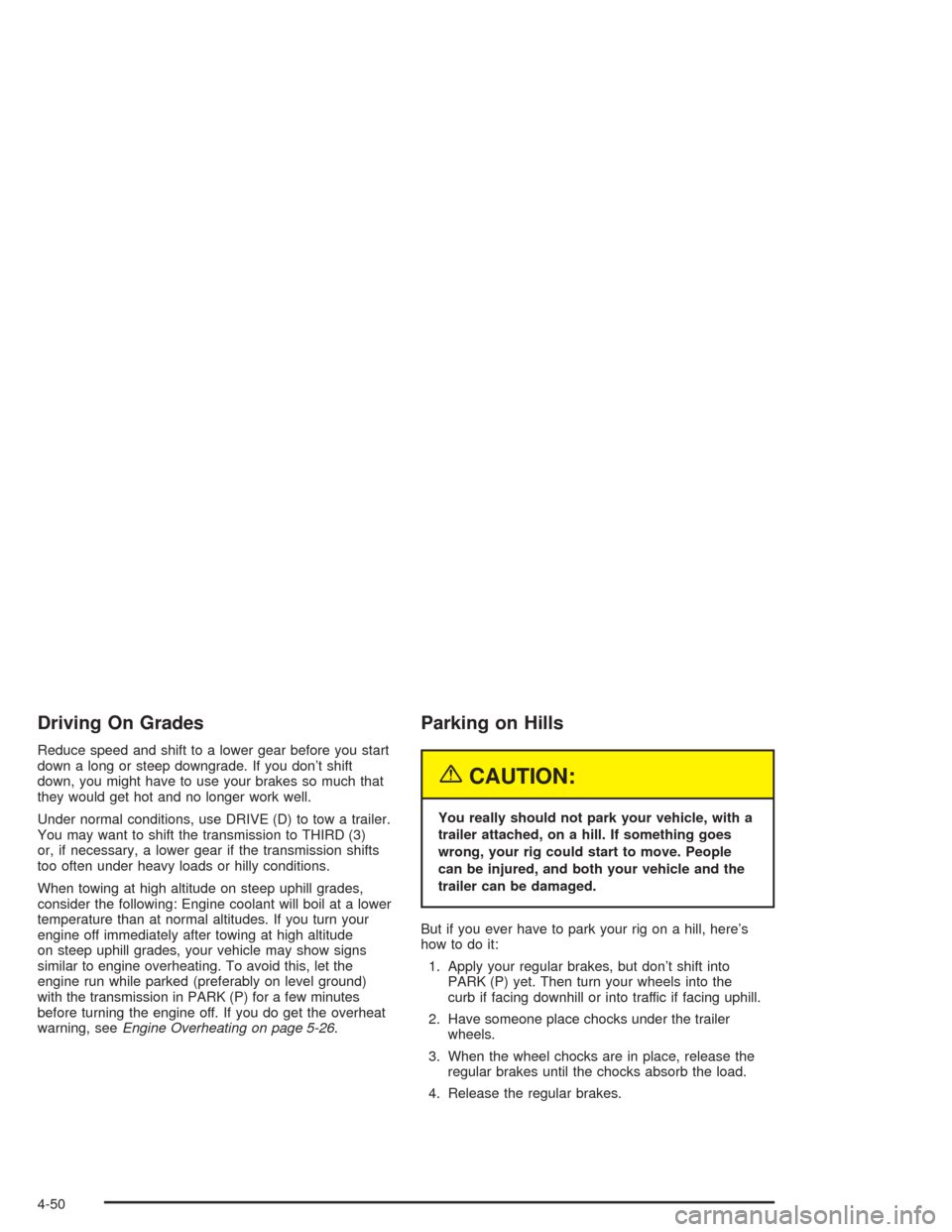
Driving On Grades
Reduce speed and shift to a lower gear before you start
down a long or steep downgrade. If you don’t shift
down, you might have to use your brakes so much that
they would get hot and no longer work well.
Under normal conditions, use DRIVE (D) to tow a trailer.
You may want to shift the transmission to THIRD (3)
or, if necessary, a lower gear if the transmission shifts
too often under heavy loads or hilly conditions.
When towing at high altitude on steep uphill grades,
consider the following: Engine coolant will boil at a lower
temperature than at normal altitudes. If you turn your
engine off immediately after towing at high altitude
on steep uphill grades, your vehicle may show signs
similar to engine overheating. To avoid this, let the
engine run while parked (preferably on level ground)
with the transmission in PARK (P) for a few minutes
before turning the engine off. If you do get the overheat
warning, seeEngine Overheating on page 5-26.
Parking on Hills
{CAUTION:
You really should not park your vehicle, with a
trailer attached, on a hill. If something goes
wrong, your rig could start to move. People
can be injured, and both your vehicle and the
trailer can be damaged.
But if you ever have to park your rig on a hill, here’s
how to do it:
1. Apply your regular brakes, but don’t shift into
PARK (P) yet. Then turn your wheels into the
curb if facing downhill or into traffic if facing uphill.
2. Have someone place chocks under the trailer
wheels.
3. When the wheel chocks are in place, release the
regular brakes until the chocks absorb the load.
4. Release the regular brakes.
4-50
Page 257 of 398
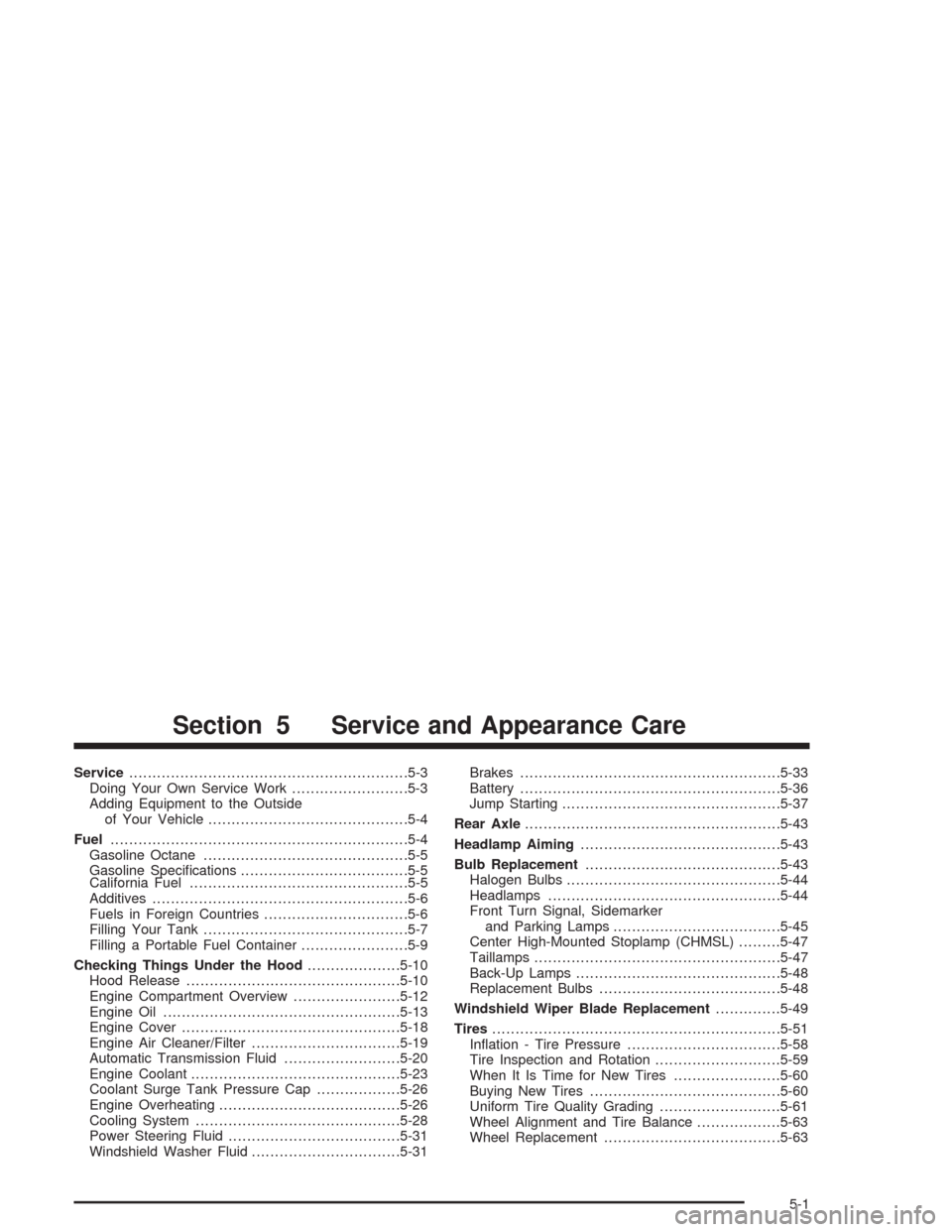
Service............................................................5-3
Doing Your Own Service Work.........................5-3
Adding Equipment to the Outside
of Your Vehicle...........................................5-4
Fuel................................................................5-4
Gasoline Octane............................................5-5
Gasoline Speci�cations....................................5-5
California Fuel...............................................5-5
Additives.......................................................5-6
Fuels in Foreign Countries...............................5-6
Filling Your Tank............................................5-7
Filling a Portable Fuel Container.......................5-9
Checking Things Under the Hood....................5-10
Hood Release..............................................5-10
Engine Compartment Overview.......................5-12
Engine Oil...................................................5-13
Engine Cover...............................................5-18
Engine Air Cleaner/Filter................................5-19
Automatic Transmission Fluid.........................5-20
Engine Coolant.............................................5-23
Coolant Surge Tank Pressure Cap..................5-26
Engine Overheating.......................................5-26
Cooling System............................................5-28
Power Steering Fluid.....................................5-31
Windshield Washer Fluid................................5-31Brakes........................................................5-33
Battery........................................................5-36
Jump Starting...............................................5-37
Rear Axle.......................................................5-43
Headlamp Aiming...........................................5-43
Bulb Replacement..........................................5-43
Halogen Bulbs..............................................5-44
Headlamps..................................................5-44
Front Turn Signal, Sidemarker
and Parking Lamps....................................5-45
Center High-Mounted Stoplamp (CHMSL).........5-47
Taillamps.....................................................5-47
Back-Up Lamps............................................5-48
Replacement Bulbs.......................................5-48
Windshield Wiper Blade Replacement..............5-49
Tires..............................................................5-51
In�ation - Tire Pressure.................................5-58
Tire Inspection and Rotation...........................5-59
When It Is Time for New Tires.......................5-60
Buying New Tires.........................................5-60
Uniform Tire Quality Grading..........................5-61
Wheel Alignment and Tire Balance..................5-63
Wheel Replacement......................................5-63
Section 5 Service and Appearance Care
5-1
Page 266 of 398
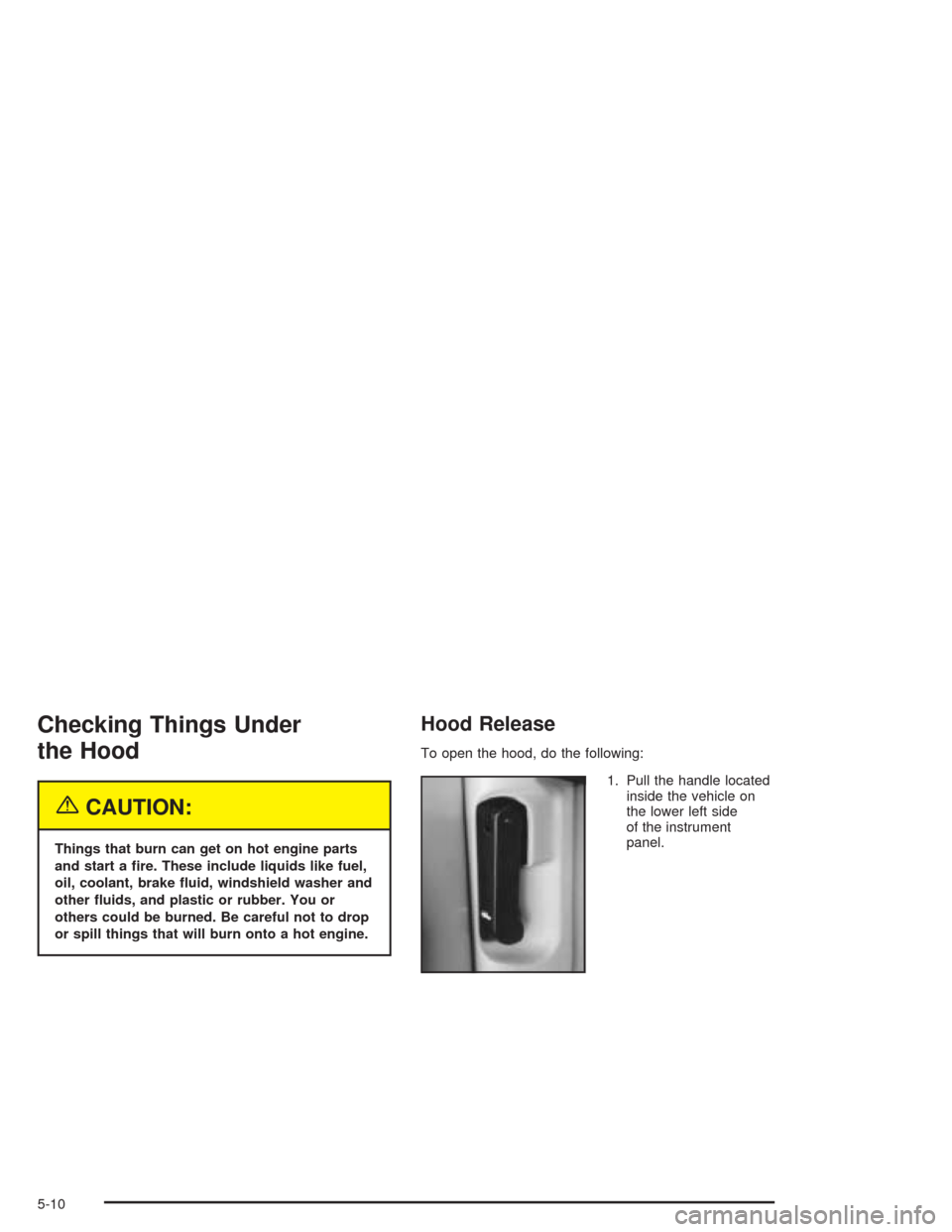
Checking Things Under
the Hood
{CAUTION:
Things that burn can get on hot engine parts
and start a �re. These include liquids like fuel,
oil, coolant, brake �uid, windshield washer and
other �uids, and plastic or rubber. You or
others could be burned. Be careful not to drop
or spill things that will burn onto a hot engine.
Hood Release
To open the hood, do the following:
1. Pull the handle located
inside the vehicle on
the lower left side
of the instrument
panel.
5-10
Page 269 of 398
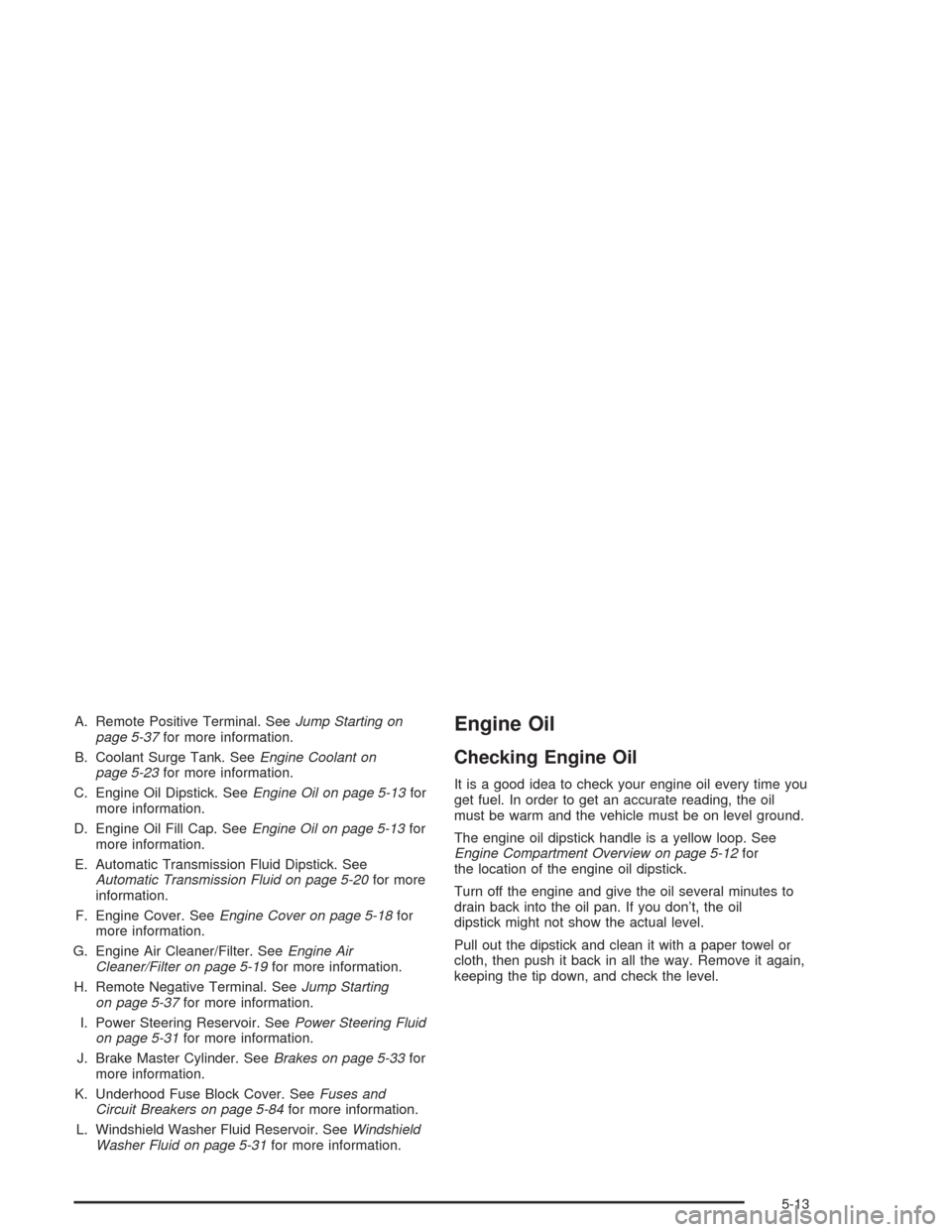
A. Remote Positive Terminal. SeeJump Starting on
page 5-37for more information.
B. Coolant Surge Tank. SeeEngine Coolant on
page 5-23for more information.
C. Engine Oil Dipstick. SeeEngine Oil on page 5-13for
more information.
D. Engine Oil Fill Cap. SeeEngine Oil on page 5-13for
more information.
E. Automatic Transmission Fluid Dipstick. See
Automatic Transmission Fluid on page 5-20for more
information.
F. Engine Cover. SeeEngine Cover on page 5-18for
more information.
G. Engine Air Cleaner/Filter. SeeEngine Air
Cleaner/Filter on page 5-19for more information.
H. Remote Negative Terminal. SeeJump Starting
on page 5-37for more information.
I. Power Steering Reservoir. SeePower Steering Fluid
on page 5-31for more information.
J. Brake Master Cylinder. SeeBrakes on page 5-33for
more information.
K. Underhood Fuse Block Cover. SeeFuses and
Circuit Breakers on page 5-84for more information.
L. Windshield Washer Fluid Reservoir. SeeWindshield
Washer Fluid on page 5-31for more information.Engine Oil
Checking Engine Oil
It is a good idea to check your engine oil every time you
get fuel. In order to get an accurate reading, the oil
must be warm and the vehicle must be on level ground.
The engine oil dipstick handle is a yellow loop. See
Engine Compartment Overview on page 5-12for
the location of the engine oil dipstick.
Turn off the engine and give the oil several minutes to
drain back into the oil pan. If you don’t, the oil
dipstick might not show the actual level.
Pull out the dipstick and clean it with a paper towel or
cloth, then push it back in all the way. Remove it again,
keeping the tip down, and check the level.
5-13
Page 279 of 398
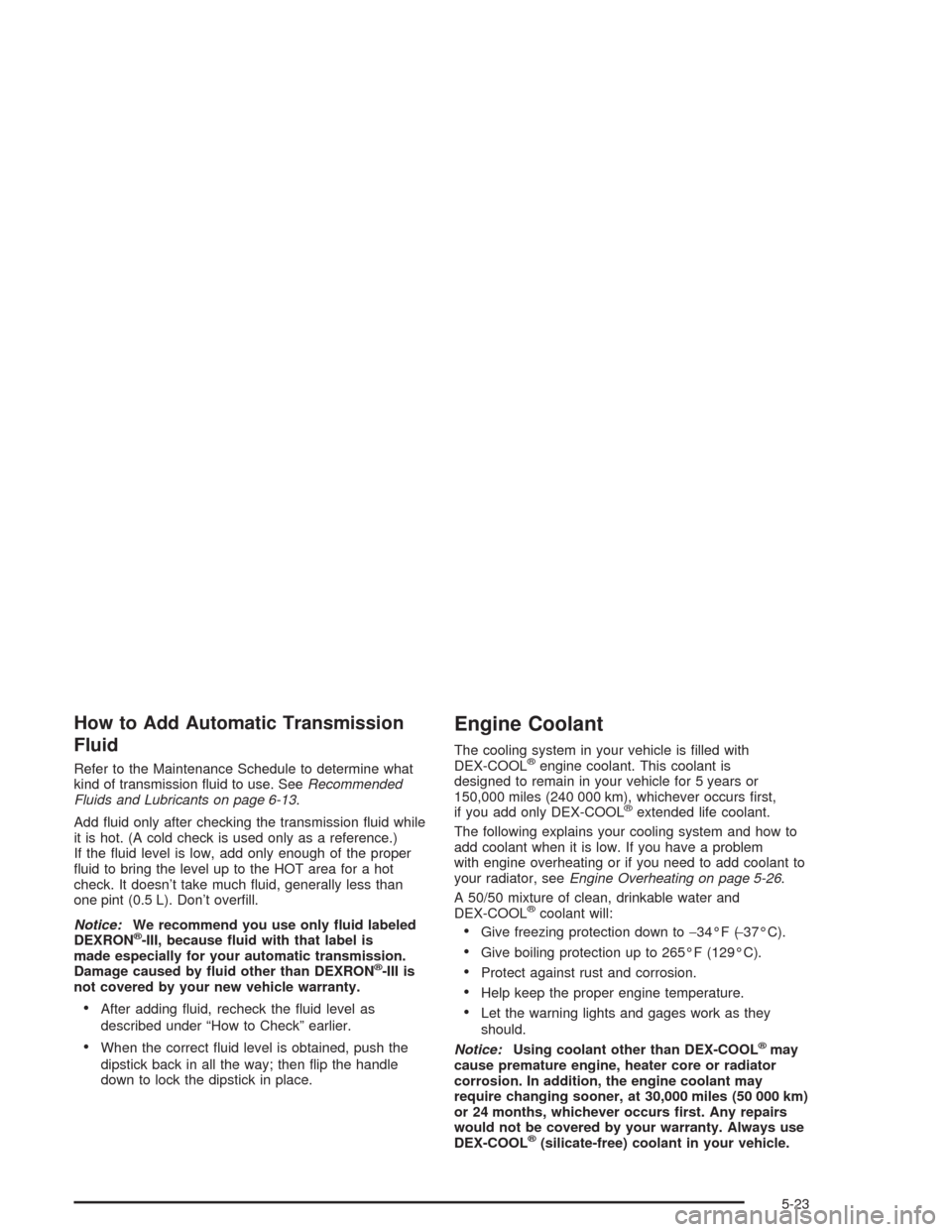
How to Add Automatic Transmission
Fluid
Refer to the Maintenance Schedule to determine what
kind of transmission �uid to use. SeeRecommended
Fluids and Lubricants on page 6-13.
Add �uid only after checking the transmission �uid while
it is hot. (A cold check is used only as a reference.)
If the �uid level is low, add only enough of the proper
�uid to bring the level up to the HOT area for a hot
check. It doesn’t take much �uid, generally less than
one pint (0.5 L). Don’t over�ll.
Notice:We recommend you use only �uid labeled
DEXRON
®-III, because �uid with that label is
made especially for your automatic transmission.
Damage caused by �uid other than DEXRON
®-III is
not covered by your new vehicle warranty.
After adding �uid, recheck the �uid level as
described under “How to Check” earlier.
When the correct �uid level is obtained, push the
dipstick back in all the way; then �ip the handle
down to lock the dipstick in place.
Engine Coolant
The cooling system in your vehicle is �lled with
DEX-COOL®engine coolant. This coolant is
designed to remain in your vehicle for 5 years or
150,000 miles (240 000 km), whichever occurs �rst,
if you add only DEX-COOL
®extended life coolant.
The following explains your cooling system and how to
add coolant when it is low. If you have a problem
with engine overheating or if you need to add coolant to
your radiator, seeEngine Overheating on page 5-26.
A 50/50 mixture of clean, drinkable water and
DEX-COOL
®coolant will:
Give freezing protection down to−34°F (−37°C).
Give boiling protection up to 265°F (129°C).
Protect against rust and corrosion.
Help keep the proper engine temperature.
Let the warning lights and gages work as they
should.
Notice:Using coolant other than DEX-COOL
®may
cause premature engine, heater core or radiator
corrosion. In addition, the engine coolant may
require changing sooner, at 30,000 miles (50 000 km)
or 24 months, whichever occurs �rst. Any repairs
would not be covered by your warranty. Always use
DEX-COOL
®(silicate-free) coolant in your vehicle.
5-23
Page 280 of 398
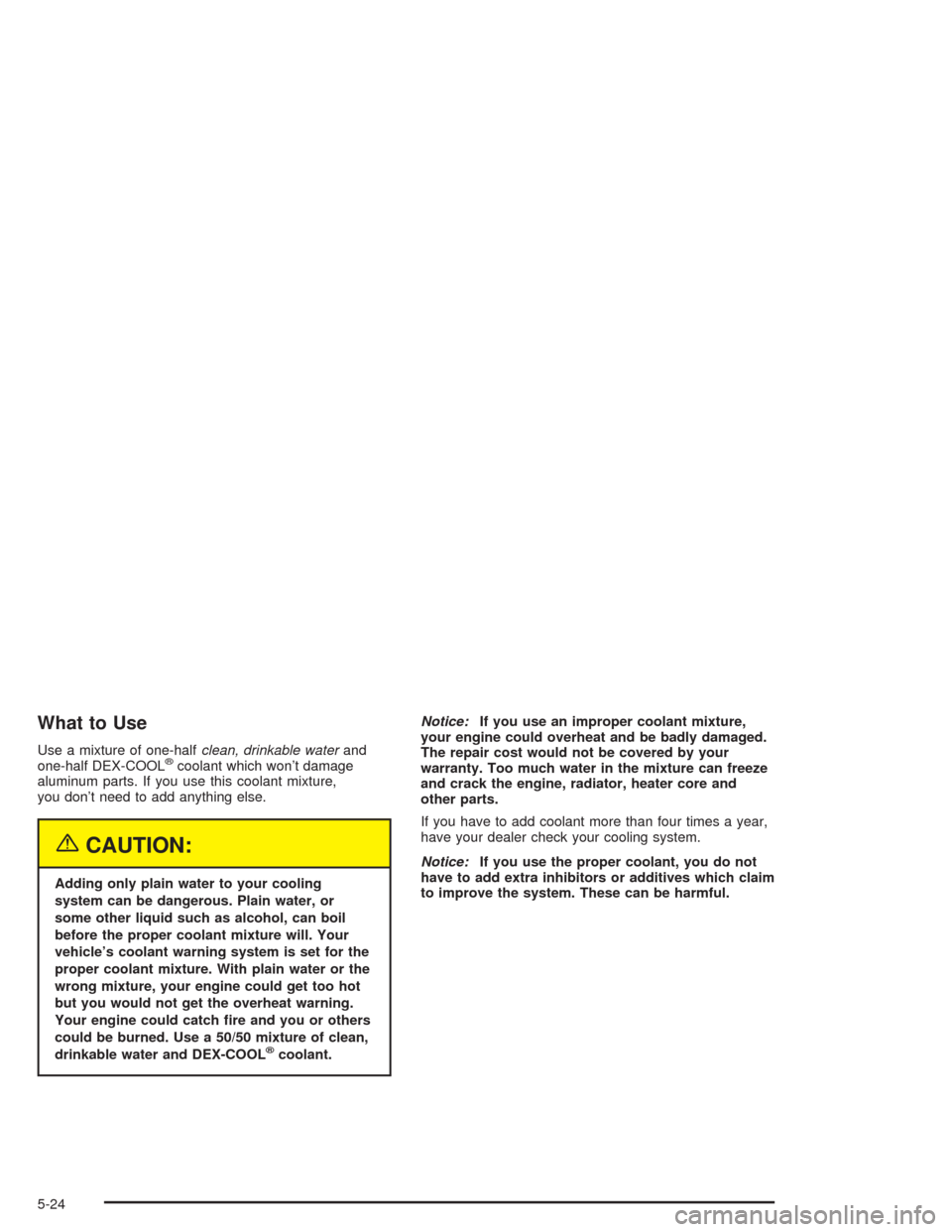
What to Use
Use a mixture of one-halfclean, drinkable waterand
one-half DEX-COOL®coolant which won’t damage
aluminum parts. If you use this coolant mixture,
you don’t need to add anything else.
{CAUTION:
Adding only plain water to your cooling
system can be dangerous. Plain water, or
some other liquid such as alcohol, can boil
before the proper coolant mixture will. Your
vehicle’s coolant warning system is set for the
proper coolant mixture. With plain water or the
wrong mixture, your engine could get too hot
but you would not get the overheat warning.
Your engine could catch �re and you or others
could be burned. Use a 50/50 mixture of clean,
drinkable water and DEX-COOL
®coolant.Notice:If you use an improper coolant mixture,
your engine could overheat and be badly damaged.
The repair cost would not be covered by your
warranty. Too much water in the mixture can freeze
and crack the engine, radiator, heater core and
other parts.
If you have to add coolant more than four times a year,
have your dealer check your cooling system.
Notice:If you use the proper coolant, you do not
have to add extra inhibitors or additives which claim
to improve the system. These can be harmful.
5-24